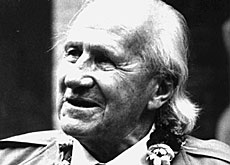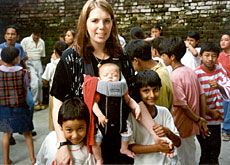Celebrating 50 years of climbing Everest

On May 29, 1953, a New Zealand beekeeper and a Nepali Sherpa became the first people to scale the world's highest peak.
Fifty years on, a team of 14 Swiss climbers – including a camera crew – has been attempting to follow in the footsteps of Edmund Hillary and Tenzing Norgay.
Swiss German television is currently screening a documentary series about the Swiss expedition, showing the hardships of scaling the 8,850-metre summit in the Nepalese Himalayas.
The team set out at the beginning of April to conquer the peak. But on May 22, just 250 metres from the top, they were forced to turn back by bad weather.
The group’s mountain guide, Kari Kobler, who’s the only Swiss to have scaled Everest twice, says the decision to turn back was agonising… but right.
“I was very sad when I had to make the decision to turn back but I’m also very happy nobody fell ill,” he told swissinfo upon arriving in the Nepalese capital, Kathmandu.
“Every team had at least one case of snow-blindness, frozen fingers and toes and broken legs – we had nothing.”
But even though the team did not make it all the way to the summit, the series producer, Beat Wieser, does not think his programme will fall apart.
“It would have been beautiful if they had succeeded, but mountain climbing is always a risk and that’s what we want to show,” Wieser told swissinfo.
Magic number
The Swiss team turned back at an altitude of 8,600 metres – the same height at which another Swiss expedition was forced to abort its mission to scale Everest, back in 1952.
Had they succeeded, Raymond Lambert and Sherpa Tenzing Norgay would have been the first to scale Everest’s heights and would have beaten Hillary and his British expedition.
“It might be a magic number for the Swiss,” Kobler chuckled. “And it’s definitely a magic number for anyone scaling the north side, as we did, because that’s where the famous second step begins – a difficult climb.”
Traffic jam
The decision to turn back was also due in part to the huge number of people on Mount Everest, who had all set out on the same day because of a favourable weather forecast.
“There were too many people on the mountain and I think the team would have had to wait for about three hours,” Wieser explains.
However, a day later, on May 23, the weather finally improved and dozens of people managed to summit, including the fastest person and the oldest man.
But by then it was too late for Kobler’s team.
“After the big storm and the cold, the team members were just too weak for another summit bid,” Wieser said. “They didn’t have any energy left.”
Commercialisation
The mounting “traffic jams” on Everest are a product of the growing number of commercial expeditions on the mountain over the last 50 years, which critics say have contributed to the climbers’ risks.
Organisers of commercial expeditions – which cost up to SFr65,000 ($50,000) per climber – have recently come under fire for “dragging” inexperienced climbers up the mountain.
On a single afternoon in May 1996, for example, 23 climbers reached the top of the world – but eight lost their lives on their return due to the climbers’ inexperience.
For Yves Lambert, who scaled Everest last year in a bid to fulfil his father Raymond’s dream, the amount of people trying to climb the sacred mountain has added to the risk.
“There were another 60 people who made it to the top on the same day as us,” Lambert explains.
“The mountain itself is not that dangerous, however, the increasing number of people and the inexperience of the people make it dangerous.”
Swiss-German television is screening the documentary series every Sunday, which started on May 25th.
swissinfo, Billi Bierling
Sherpa Tenzing Norgay and Edmund Hillary first climbed Everest on 29th May 1953.
The Swiss Raymond Lambert, and Sherpa Tensing Norgay made it to 8,600 metres in 1952.
More than 1,200 people have climbed Mount Everest and more than 170 have died.
In 1956, a Swiss team made it to the top of the world.

In compliance with the JTI standards
More: SWI swissinfo.ch certified by the Journalism Trust Initiative


You can find an overview of ongoing debates with our journalists here. Please join us!
If you want to start a conversation about a topic raised in this article or want to report factual errors, email us at english@swissinfo.ch.